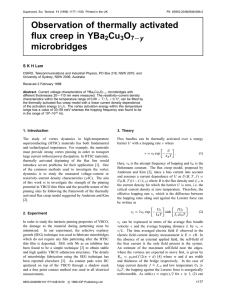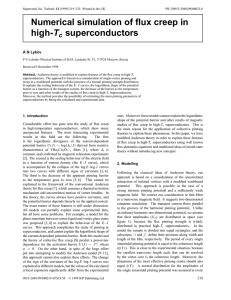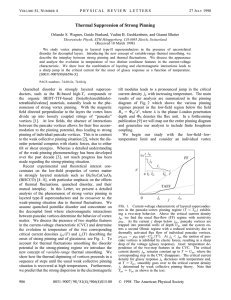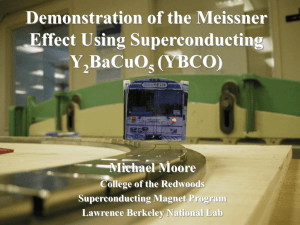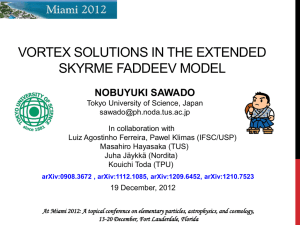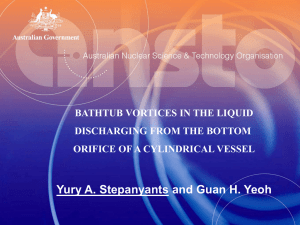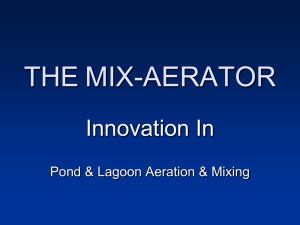Lect I
advertisement
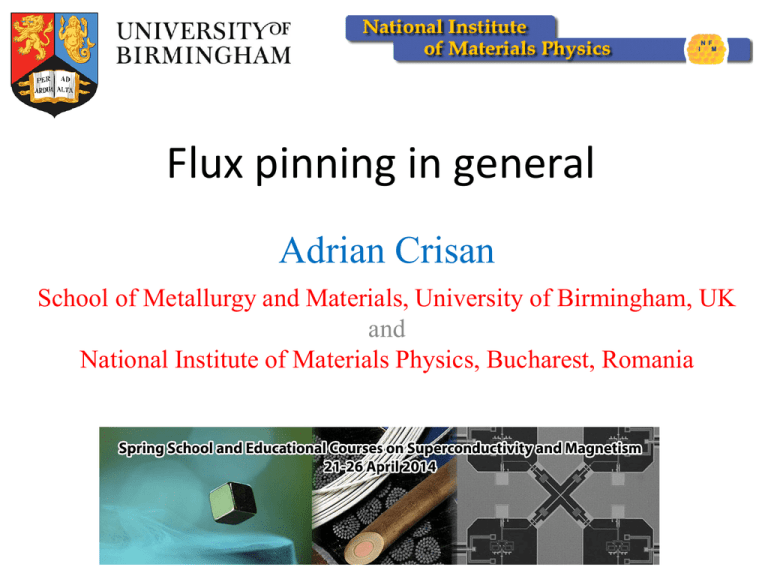
Flux pinning in general Adrian Crisan School of Metallurgy and Materials, University of Birmingham, UK and National Institute of Materials Physics, Bucharest, Romania CONTENTS • Introduction: type I vs. type II • Vortices • Pinning • Bulk Pinning Force Density • Pinning Potential INTRODUCTION: Type I vs. Type II Type I superconductors - They cannot be penetrated by magnetic flux lines (complete Meissner effect) - They have only a single critical field at which the material ceases to superconduct, becoming resistive - They are usually elementary metals, such as aluminium, mercury, lead Type II superconductors - Gradual transition from superconducting to normal with an increasing magnetic field - Typically they superconduct at higher temperatures and fields than Type I - Between Meissner and normal state there is a large “mixed” or “vortex” state - They have two critical fields (upper and lower) - They are ussually metal alloys, intermetallic compounds, complex oxides (e.g., Cu-based HTSC) and, recently discovered, pnictides and chalcogenides Phase diagram of “classical” superconductors Penetration depth (l) - Diamagnetic material (no internal flux) - Currents to repel external flux confined to surface - Surface currents must flow in finite thickness (penetration depth l) Coherence length (x) - characterises the distance over which the superconducting wave function y(r) can vary without undue energy increase - the distance over which the superconducting carriers concentration decreases by Euler’s number e - GL parameter k=l/x; if k<1/21/2 then Type I; k>1/21/2 then Type II II. VORTICES Vortex (mixed) state - Normal regions thread through superconductor - Ratio between surface and volume of the normal phase is maximised - Cylinders of normal material parallel to the applied field (normal cores) - Cores arranged in regular pattern to minimize repulsion between cores (close-packed hexagonal lattice) – flux lattice Flux quanta - vortex Phase diagram of High-Tc superconductors and Vortex Melting Lines The vortex lattice undergoes a first-order melting transition transforming the vortex solid into a vortex liquid [Fisher et al, PRB 43,130, 1991]. For high anisotropy, at low magnetic fields (approx 1 Oe in BSCCO [A.C. et al, SuST 24, 115001, 2011), there is a reentrance of the melting line [Blatter et al, PRB 54, 72, 1996]. The flux lines in the vortex -liquid are entangled resulting in an ohmic longitudinal response, hence the vortex liquid and normal metallic phases are separated by a crossover at Hc2. For low enough currents -VL- linear dissipation: E ≈ J -VS (VGlass)- strongly nonlinear dissipation: E ≈ exp[-(JT/J)m] III. PINNING Lorenz force (FL) and pinning force (Fp) In the presence of a magnetic field perpendicular to the current direction, a Lorentz force FL = j ×f0, where j is the current and f0 is the magnetic flux quantum, acts on the vortices • If FL is smaller than the pinning force Fp, vortices do not move. Defect-free sample Point defects Columnar defects Dimensionality and strength of PCs IV. BULK PINNING FORCE DENSITY • FP determined from magnetization loops M(Ha) Fp=BxJc Jc=Ct.DM Jc 4m a a bd (1 ) 3b . 2 (thin films; m=DM/2; d-thickness; a,b-rectangle dim.) Dew-Hughes model F = Fp/Fpmax = hp(1-hq) ; h = B/Birr p and q depend on the types of pinning centres. - Classified by the number of dimensions that are large compared with the inter-flux-line spacing; and - by the type of the core: “Dk pinning” and “normal pinning” Ususlly there are several types of pinning centres. F = Ahp1(1-hq1)+Bhp2(1-hq2)+Chp3(1-hq3)+....... D. Dew-Hughes, Philosophical Magazine 30 (1974) 293 Max. maximum Const. p=0; q=2 - A=1 Bh(1-h) p=1; q=1 h=0.5 B=4 Normal Ch1/2(1-h)2 p=1/2; q=2 h=0.2 C=3.5 Δκ Dh3/2(1-h) p=3/2; q=1 h=0.6 D=5.37 Normal Eh(1-h)2 p=1; q=2 h=0.33 E=6.76 Δκ Fh2(1-h) p=2; q=1 h=0.67 F=6.76 Type of Pinning of pin centre function Volume Normal A(1-h)2 Δκ Surface Point p, q Position of Geometry 0.3 1.0 Volume normal; (1-h)2, no max; F=1 0.8 0.2 0.6 0.4 0.1 Surface n; h1/2(1-h)2 ; max at 0.2, Fm=0.286, B= 3.5 0.2 0 0 0.2 0.4 0.6 0.8 0.25 0.2 0.4 0.6 0.8 0.20 0.20 0.15 0.15 0.10 0.10 0.05 0.05 Volume Dk; h(1-h) , max at 0.5, Fm=0.25, A=4 Surface Dk; h3/2(1-h) ; max at 0.6, Fmax=0.186, C=5.37 0 0.2 0.4 0.6 0.8 0 0.2 0.4 0.6 0.8 0.15 0.15 0.10 0.10 Point n; h(1-h)2; max at 0.33, Fmax=0.148, D=6.76 0.05 0.05 0 0 0.2 0.4 0.6 0.8 Point Dk; h2(1-h) ; max at 0.67, Fmax=0.148; E=6.76 0.2 0.4 0.6 0.8 V. PINNING POTENTIAL • Energy needed by the flux line to escape from the potential well crated by the pinning centre • Shape and influence on superconducting properties modelled in several ways, depending on material, strength and distribution of pinning centres • In 1962 Anderson predicted that movement of vortices with a drift velocity v will create dissipation (electric field) E=Bxv Dissipation occurs through two mechanisms: • 1. Dipolar currents which surround each moving flux line (eddy currents) and which have to pass through “normal conducting vortex core” • 2. Retarded relaxation of the order parameter when vortex core moves • Anderson and Kim predicted that thermal depinning of flux lines can occur at finite temperatures T (“flux creep”). Anderson-Kim model • Model assumes that flux creep occurs due to thermally-activated jump of isolated bundles of flux lines between two adjacent pinning centres. • The jump is correlated for a bundle of vortices of volume (correlated volume), Vc due to the interactions between them • In the absence of transport current (i.e., no Lorentz force) the bundle is placed in a rectangular potential well of height Uo. • Due to thermal energy, there are jumps over the barier with a frequency = oexp(-Uo/kT) f b 0 e (3) (2) (1) U 0 BJvx kT 0 e U 0 BJvx kt U f U 0 BJvx U 0 BJ0vxJ0 / J (1) (2) U 0 (1 J / J 0 ) U b U 0 (1 J / J 0 ) (3) 0 (e (1): I=0 (2): 0<I<Io (3): I=Io Second term is ussualy neglected, since current densities of interest are smaller than J0 Critical current density is defined arbitrarily at a certain electric field, e.g., 10-6 V/cm. It follows: Uf kT U e 0 e 0 (1 J c Ub kT ) / J0 ) kT U0 Jc ln (1 ) kT J0 0 J c ln ln(t ) 0 Logarithmic decay, magnetic relaxation J; M (a.u.) ln (t) K-A model: -pinning potential decreases linearly with current -remnant magnetization and persistent current (or critical current density) decay logarithmically with time Modified Anderson-Kim model • Tilted-washboard cosine potential, which leads to U=U0[1-(J/Jc)]3/2 • The two forms can be generalized as U=U0[1-(J/Jc)] • Such forms focus on the detailed behavior near Jc, which is appropriate for the classic superconductors where fluctuation effects cause only slight degradation of Jc Larkin-Ovchinnikov collective pinning model • Cooperative aspects of vortex dynamics • Formation of vortex lattice will be a result of a competition between: -vortex-vortex interaction, which tends to place a vortex on a lattice point of a periodic hexagonal/triangular lattice; and - vortex-pin interaction, which tends to place a vortex on the local minimum of the pinning potential • v-v interaction promotes global translational invariant order • v-p interaction tend to suppress such long-range order, if pinning potential varies randomly • Long-range order of an Abrikosov lattice is destroyed by a random pinning potential, no matter how weak it is. • Periodic arrangement is preserved only in a small corellated volume vc which depends on the strength of the pinning potential and the elasticity of the vortex lines • Correlated volume vc increase strongly with decreasing current density J, which leads to a power-law dependence of effective pinning potential on the current density m Jc U ( J ) U0 ; m 1 J The above dependence leads to a non-ohmic current-voltage characteristic of the form: U 0 J c m V exp kT J In an inductive circuit, V is proportional to dJ/dt J (t ) J c 1 (kT / U 0 ) ln(1 t / t0 ) kT t J (t ) J c ln U 0 t0 1 / m T010-6 s kT 0 J c ln U0 1 / m Zeldov effective pinning • Magneto-resistivity and I-V curves of YBCO films • Potential well having a cone-like structure exhibiting a cusp at its minimum and a broad logarithmic decay with the distance U eff J* U 0 ln J U eff V exp kT U0 U0 * U 0 J * J * kT J kT V Ct. exp ln Ct. expln Ct. J kT J J E. Zeldov et al, PRL 62, (1989) 3093 , PRL . 56, (1990) 680 A.C. et al, SuST 22, 045014, 2009
